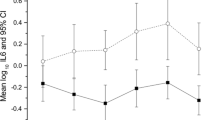Abstract
In this second episode of the Microbiologist in the Clinic series, clinicians and laboratory scientists share their perspectives about a 75-year-old woman who was diagnosed with asymptomatic bacteriuria based on positive urine cultures. The patient and her GP are concerned about this laboratory finding as the patient will become immunosuppressed with planned chemotherapy. The patient has had an overactive bladder (OAB) for approximately 20 years, with good control of her urinary urgency and frequency (no incontinence) with a stable dose of OAB medication. The challenges of this clinical presentation are discussed, with evidence for evaluation and treatment.
Similar content being viewed by others
References
Abraham SN, Miao Y. The nature of immune responses to urinary tract infections. Nat Rev Immunol. 2015;15(10):655–63. https://doi.org/10.1038/nri3887.
Falagas ME, Kotsantis IK, Vouloumanou EK, Rafailidis PI. Antibiotics versus placebo in the treatment of women with uncomplicated cystitis: a meta-analysis of randomized controlled trials. J Infect. 2009;58(2):91–102. https://doi.org/10.1016/j.jinf.2008.12.009.
Nielsen KL, Dynesen P, Larsen P, Frimodt-Møller N. Faecal Escherichia coli from patients with E. coli urinary tract infection and healthy controls who have never had a urinary tract infection. J Med Microbiol. 2014;63(4):582–9. https://doi.org/10.1099/jmm.0.068783-0.
Hayes BW, Abraham SN. Innate immune responses to bladder infection. Microbiol Spectr. 2016;4(6). https://doi.org/10.1128/microbiolspec.uti-0024-2016.
Sarkissian Milner CA, Alteri CJ, Mobley HLT. UTI patients have pre-existing antigen-specific antibody titers against UTI vaccine antigens. Vaccine. 2019;37(35):4937–46. https://doi.org/10.1016/j.vaccine.2019.07.031.
Wu J, Hayes BW, Phoenix C, et al. A highly polarized TH2 bladder response to infection promotes epithelial repair at the expense of preventing new infections. Nat Immunol. 2020;21(6):671–83. https://doi.org/10.1038/s41590-020-0688-3.
Chieng CCY, Kong Q, Liou NSY, Khasriya R, Horsley H. The clinical implications of bacterial pathogenesis and mucosal immunity in chronic urinary tract infection. Mucosal Immunol. 2023;16(1):61–71. https://doi.org/10.1016/j.mucimm.2022.12.003.
Brubaker L. Forming consensus to advance urobiome research. mSystems. 2021;6(4):164971.
Antoniou V, Somani BK. Topical and oral oestrogen for recurrent urinary tract infection—evidence-based review of literature, treatment recommendations, and correlation with the European Association of Urology guidelines on urological infections. Eur Urol Focus. 2022;8(6):1768–74.
Brubaker L, Chai T, Horsley H, Khasriya R, Moreland RB, Wolfe AJ. Tarnished gold–the “standard” urine culture: reassessing the characteristics of a criterion standard for detecting urinary microbes. Front Urol. 2023. https://doi.org/10.3389/fruro.2023.1206046.
Harding C, Chadwick T, Homer T, Ali A. Methenamine hippurate compared with antibiotic prophylaxis to prevent recurrent urinary tract infections in women: the ALTAR non-inferiority RCT. Health Technol Assess. 2022;26(23):1–172.
Schirrmacher V. From chemotherapy to biological therapy: a review of novel concepts to reduce the side effects of systemic cancer treatment (review). Int J Oncol. 2019;54(2):407–19. https://doi.org/10.3892/ijo.2018.4661.
Author information
Authors and Affiliations
Contributions
All authors contributed to conceptualization (as part of a 2021 IUGA workshop) and writing all drafts, in addition to review and editing.
Corresponding author
Ethics declarations
Ethical approval
As no protected health information was included in this conversational commentary, no ethical approval was sought or required.
Conflicts of interest
L.B.: editorial stipends from JAMA and Up To Date; H.H.: no disclosures; H.K.: no disclosures; A.J.W.: advisory boards at Urobiome Therapeutics and Pathnostics and funding from NIH, Craig H. Neilsen Foundation, Pathnostics, and VB Tech.
Additional information
Handling Editor: Annette Kuhn
Editor in Chief: Kaven Baessler
Publisher's Note
Springer Nature remains neutral with regard to jurisdictional claims in published maps and institutional affiliations.
Rights and permissions
Springer Nature or its licensor (e.g. a society or other partner) holds exclusive rights to this article under a publishing agreement with the author(s) or other rightsholder(s); author self-archiving of the accepted manuscript version of this article is solely governed by the terms of such publishing agreement and applicable law.
About this article
Cite this article
Brubaker, L., Horsley, H., Khasriya, R. et al. Microbiologist in the Clinic: Postmenopausal Woman with Chronic OAB and Positive Urine Culture. Int Urogynecol J (2024). https://doi.org/10.1007/s00192-024-05819-y
Received:
Accepted:
Published:
DOI: https://doi.org/10.1007/s00192-024-05819-y




